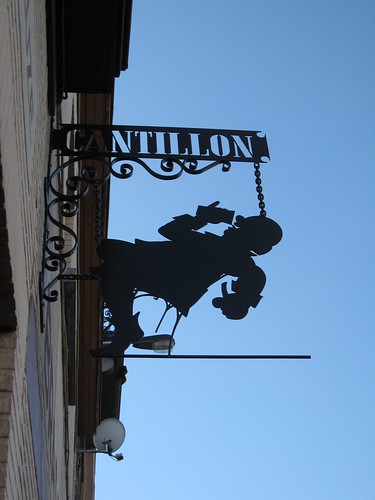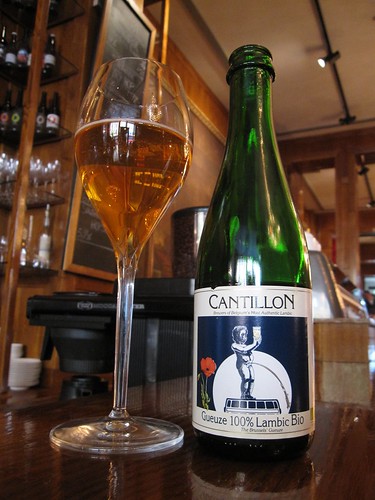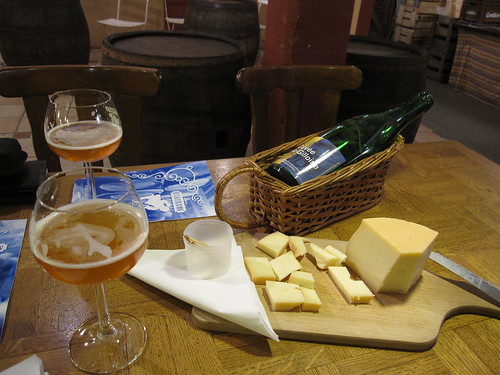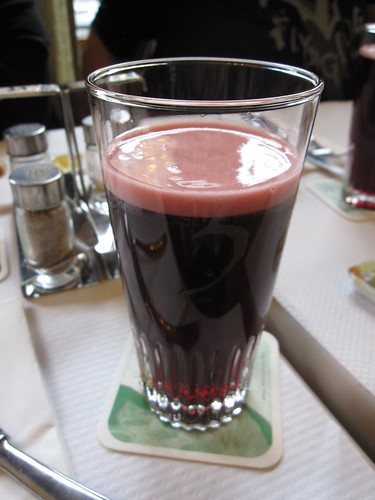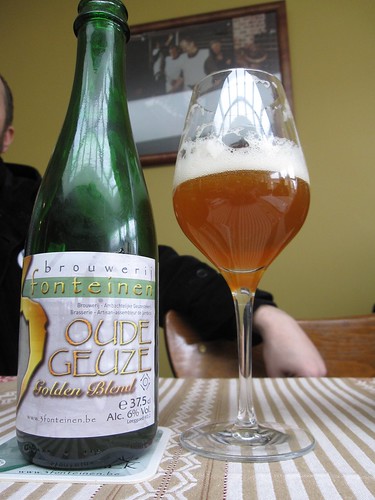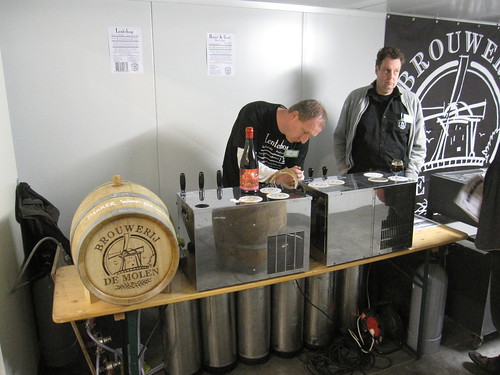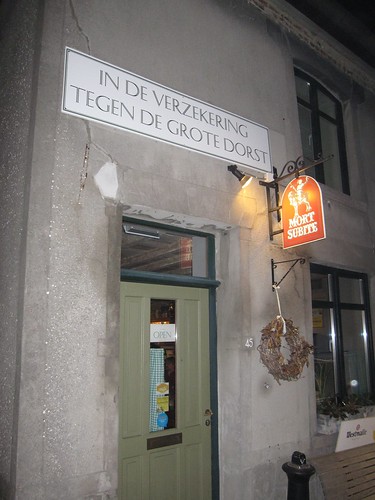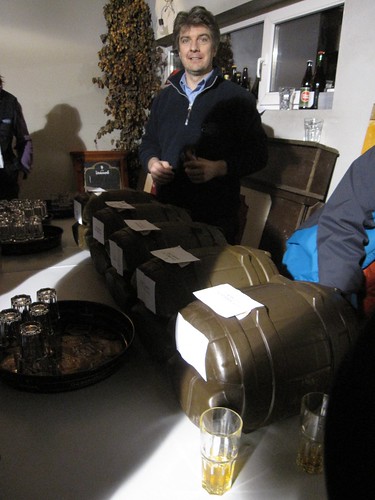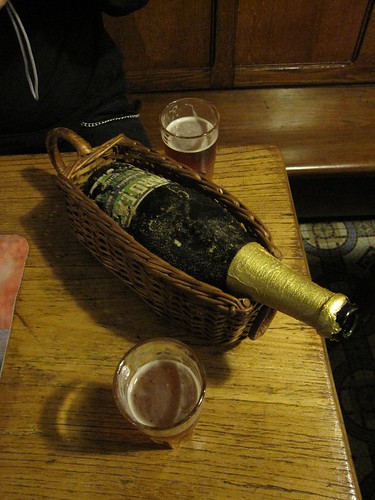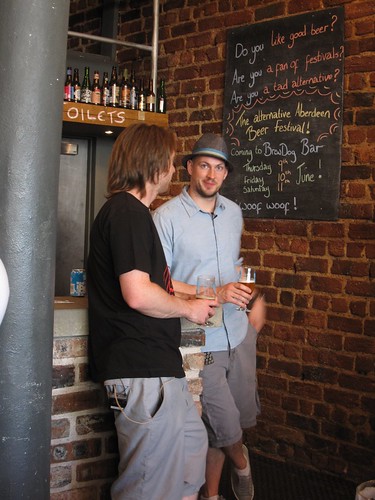 |
| Martin Dickie and James Watt. BrewDog Aberdeen, May 2011. |
Starting up a punk brewery
Back when he was still captain on a fishing boat, James Watt would dream of hoppy and full bodied beers. Like his friend, Martin Dickie, he was tired of the "insipid, mass produced chemical products churned out by big companies". In the end they got so fed up with what they could buy locally that they bought a brewing kit and started brewing American inspired pale ales in James' garage. They slowly honed their brewing skills.In 2006 Martin and James went to London to seek out the opinion of Michael "The Beer Hunter" Jackson, one of the most influential persons in the beer world at the time. He tasted their IPA, looked searchingly at them and uttered the profound words "It's time to quit your day jobs". The two duly did, spending the rest of the year securing loans to build a brewery in their hometown Fraserburgh in the far north of Aberdeenshire.
In April 2007, named BrewDog after after James’s dog Bracken, the brewery was ready for operation. But, as they've admitted since, that's when the real problems began.
Punk's not dead or how to survive in brewing
Trying to make a break in the UK beer market turned out to be easier said than done for Martin and James, their BrewDog beers were all made after the American craft beer mold - hoppy, flavorful and high in ABV. The average British beer drinker is not known for his willingness to try new flavors and even less for trying a beer much above 3.5% ABV. Thus, BrewDog immediately faced an uphill struggle in getting their beers sold.Another problem was that many pubs Martin and James contacted were already tied to large breweries and those that weren't didn't think BrewDog beers would sell enough to warrant a spot in their bar, partly because of the 30% higher price.
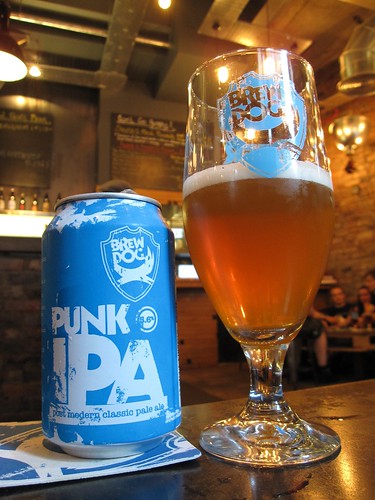 |
| Punk IPA - the original BrewDog success. |
Shortly after starting BrewDog, they had entered Punk IPA in a tasting competition for Tesco - the British multinational grocery retailer. Six months later it turned out they had won, and Tesco called them asking about selling BrewDog beers in 400 stores across Britain!
Brewdog made the Tesco order and soon got another big order from Systembolaget in Sweden who started selling Punk IPA in the spring of 2008 (which was how I got my first taste of it). By the end of 2008, they had sold beer for £800,000.
Today, Punk IPA remains their flagship beer, sold on bottle, can and keg all over Europe. And it has been followed by dozens of other beers in all styles and manners, from the darkest imperial stouts to the hoppiest india pale ales. BrewDog has also launched the experimental Abstrakt series where new and often strange recipes are tried out, sometimes very successful other times just plain weird. But what has caused most media attention have been their strong beers.
The new media kings
BrewDog have never played by the books and have a love / hate relationship with the media, which can be traced back to the July 2009 release of their "intergalactic fantastic oak aged beer" Tokyo* of 18.2% ABV. |
| BrewDog Tokyo* - hardly a teens drink. |
British journalists were outraged, calling BrewDog irresponsible and asking what was the point of such a high ABV? They claimed teenagers would drink this beer just to get clobbered every weekend. Little did the journalists reflect over the price of a BrewDog Tokyo*, which would deter most teenagers from considering this a good way to get drunk. Secondly, the massive flavors of this beer would have been more than a mouthfeel for British teens used to drinking pale, tasteless bitters or lagers. But, no, the media would not listen to that kind of arguments.
BrewDog never let the media reactions stop them. Instead they hit back, creating a ridiculously hoppy beer of just 1% ABV - Nanny State - which packed more punch than all Bitters in Britain combined, but with hardly any alcohol. Today, an even lower alcohol version of Nanny State is sold as a non-alcoholic beer at many pubs across Europe.
The story doesn't end here though, oh no, BrewDog was just warming up to their own personal media war that would see them go head to head with a German brewery and finally animal activists around the world.
Tactical Nuclear Penguin - the arms race
After all the media attention, BrewDog was contacted by Kleinbrauerei Schorschbräu, a small brewery from Gunzenhausen in Bavaria, specializing in high ABV beers known as eisbocks. Eisbocks are made by freeze distilling bock beers, removing the frozen water from the chilled beer causes them to get a more intense flavor and a higher alcohol.BrewDog was not interested in paying for German secrets, instead they read up on freeze distilling and went for the throat, launching the strongest beer in the world, Tactical Nuclear Penguin - a 32% ABV freeze distilled imperial stout, in November 2009.
 |
| BrewDog Tactical Nuclear Penguin - 32% abv. |
This part of the story ends in July 2010 with The End of History, a crazy freeze-distilled beer of 55% ABV and only made in a small quanity of 11 bottles! Each bottle was enclosed in a piece of road kill and sold for £500-700 at their webshop. Despite having been killed on the roads, animal activists fumed by the lack of respect BrewDog showed for the carcasses while beer writers fumed over the high abv, claiming that what BrewDog had made had nothing to do with beer.
Despite the negative press, guess who was laughing all the way to the bank? Yes, Martin and James! From being a small, obscure brewery on the outskirts of Europe, they had made BrewDog a household name even outside beer geek circles. Orders poured in from all over the world, even a few daredevil pubs in Britain started ordering a keg or two. Today, their beers are sold in 28 countries around the globe.
Punk is certainly not dead!
The BrewDog bars
Because of the lack of response from British pubs and beer drinkers, Martin and James conceived the plan that they should do like former English breweries - start their own chain of pubs, partly to be able to sell their own beer from draft but just as importantly to educate the beer drinkers in the new ways of craft beer. |
| BrewDog Aberdeen - the first BrewDog pub. |
Thus, in October 2010 the very first BrewDog bar opened up at 17 Gallowgate in their home city, Aberdeen, followed half a year later by BrewDog Edinburgh. As of this moment they have five bars, all in the UK:
- BrewDog Aberdeen (opened: 19 October 2010)
- BrewDog Edinburgh (opened: 24 March 2011)
- BrewDog Glasgow (opened: 23 July 2011)
- BrewDog Camden (opened: 10 December 2011)
- BrewDog Nottingham (opened: 25 February 2012)
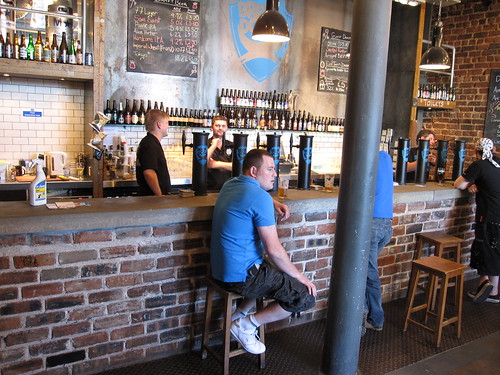 |
| The bar at BrewDog Aberdeen. |
The bar in Aberdeen is stacked with board games, chess and other forms of games that people can play at their tables, while enjoying good craft beer and a tasty pizzy or a cheese & sausage platter from the kitchen. The staff behind the bar seemed very knowledgeable about craft beer in general and the BrewDog beers in particular, so whether you come as a rookie or a seasoned beer veteran there's always helpful advices on what to try.
During my visit in May 2011, BrewDog Aberdeen had 7 BrewDog beers on tap, including Tokyo*, Alice Porter and Hardcore IPA, and four guest beers, from Stone Brewing Co and Evil Twin. All was properly poured and tasted fresh and good. There is also a good bottle selection to choose from once you've exhausted the draft beer menu, so you can easily spend several days here and just try new beers.
Photo sets from the BrewDog pubs can be found at Flickr: Aberdeen (and Edinburgh).
